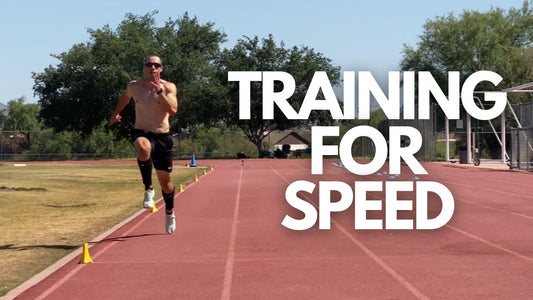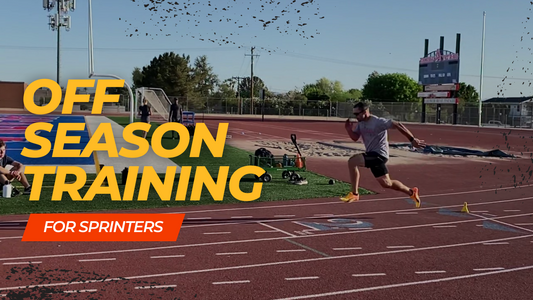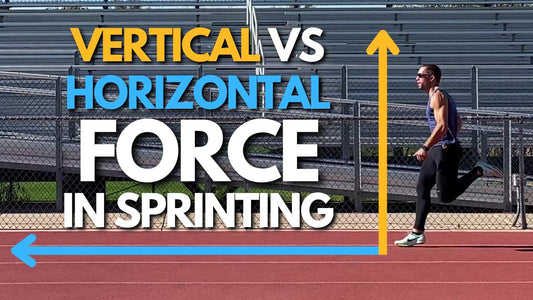How To Sprint A Faster 40 Yard Dash
How To Sprint A Faster 40 Yard Dash
One of the most well known sprints in the world is the 40 yard dash. Typically performed by American Football players as a performance test, the 40 yard dash is viewed by many as a golden ticket to get on collegiate and professional football teams.
Even for athletes who do not plan to play Division 1 NCAA or NFL football, improving the 40 yard dash can be a great way to gain an edge on the field and boost athlete confidence in themselves.
In my experience as a track & field coach and a coach for NFL combine athletes, the following article describes the best ways to get faster at running the 40 yard dash.
What This Article Will Cover
- How to train for a faster 40 yard dash.
- Acceleration training.
- Speed Training.
- Developing power, strength, and rate of force development.
- Frequently asked questions related to the 40 yard dash.
How To Train For A Faster 40 Yard Dash
To improve at the 40 yd dash, you first have to set up a sprint training program and strength training program that allows you to train the qualities needed for success in the 40 yard dash sprint. Some of the qualities that need to be developed so you can run a faster 40 include:
- Acceleration
- Sprinting Speed
- Power
- Rate Of Force Development
- Explosive Strength
- Maximal Strength
- General Strength
Throughout the rest of this page, we will cover concepts related to developing these qualities, that way you can build your own program and run a faster 40 yard dash.
Acceleration Training For A Faster 40 Yard Dash
Being only 40 yards long, or 36.5 meters, the bulk of the 40 yd dash is determined by how quickly an athlete can accelerate. Some athletes may run a very fast 40 time, but not run very fast in the 100 meter dash or 200 meter dash, and this is because the shorter distance is more a test of acceleration rather than a test of top speed or speed endurance.
Acceleration training for the 40 yard dash typically consists of sprints ranging from 10 to 30 yards, using a variety of starting positions and relatively complete rest periods of 1-5 minutes between sprints. Earlier in the preparatory training period, athletes can use a variety of starting positions, start on both legs, perform static and dynamic or rolling starts, and can experiment with technique & sprinting rhythm.
An example of an acceleration training session performed earlier in the year could look like this:
- Complete track warm up.
- 2-4 Build up accelerations over 50 yards, progressing intensity such as increasing through 70%-80%-90%-95% each sprint.
- 3x 10 yard sprints
- 3x 20 yard sprints
- 3x 30 yard sprints
An example of an acceleration training session that incorporated resisted sprinting could look like this:
- Complete track warm up.
- 2-4 Build up accelerations over 50 yards, progressing intensity such as increasing through 70%-80%-90%-95% each sprint.
- 1x Resisted 20 yard sprint, 2 point leaning start.
- 1x Unresisted 30 yard sprint, 3 point start.
Speed Training to Run A Faster 40 Yard Dash
Despite the fact that the 40 yard dash is predominantly an acceleration testing event, there is certainly a demand for maximal velocity or top speed sprinting as well. There are a few reasons for this.
First, how fast you are typically limits how quickly you can accelerate. While there is a large portion of acceleration which is dependent upon maximal force and explosive strength qualities, how quickly you accelerate after 10 yards is going to be heavily impacted by how fast you can sprint overall. The ability to quickly contract and relax muscles with proper timing and coordination is something that is required for acceleration speed, and this is improved by improving an athlete's maximal speed capabilities.

Second, the zone from 25 yards to 40 yards is strongly tied to one's top speed sprinting capabilities. Aside from professional 100 meter dash sprinters, the fastest athletes are going to reach top speed somewhere between 30 and 50 yards. While their speeds may not be as high as the professional sprinters, and the distance at which they hit their top speed will be closer than elite sprinters, fast football players will still hit high velocities by the end of the 40 yard dash.
The fastest speeds recorded in NFL games have reached as high as 23 miles per hour, which is equivalent to running a 0.97 10 meter split. This is pretty fast considering football is played on turf or grass with heavy protective equipment!
An example of a speed training session for the 40 yard dash could be:
- Complete track warm up.
- 2-4 Build up accelerations over 50 yards, progressing intensity such as increasing through 70%-80%-90%-95% each sprint.
- 3-4x Flying 20 yard sprints (smoothly accelerate over 15-30 yards, then run 20 yards as fast as possible)
Strength Training to Run A Faster 40 Yard Dash
One of the lowest hanging fruit in the world of speed development and sports performance training is the benefits that come from a well designed strength training program. Strength training itself encompasses the development of a wide range of physical characteristics, such as the development of maximal strength, power, explosive strength, rate of force development, tissue resilience, and in some ways even mobility.

Without getting into too complex of a discussion, strength training for improving the 40 yard dash should cover various points on the force-velocity spectrum, especially when you have a significant amount of time to prepare before you intend to get timed running the 40. In situations where you have only a few weeks to prepare, structuring your training program becomes more of a challenge due to time constraints, delayed training effects, and the risk of being fatigued when you get timed.
General Strength Training
Underlying all other expressions of force is general strength. General strength is the ability to move your body without additional load through full ranges of motion. Being able to squat, do push ups and pull ups, step ups, etc. are all examples of general strength. General strength is trained using circuits, with various exercises performed in a series with minimal rest in between. These workouts develop general strength, mobility, and general conditioning. Athletes can add a light medicine ball to these workouts for greater difficulty and for a wider range of exercises.
These types of workouts are initially used for conditioning, but eventually become recovery oriented workouts that are used between high intensity days. They allow for blood flow and lactate production which assist in recovery between harder workouts, and they offer a way to build and maintain cardiovascular fitness without more running.
Maximal Strength Training
Maximal strength is the ability to produce large amounts of force against external objects, such as a bar or the earth. Maximal strength is exhibited at maximal intensity and slow velocities. Maximal strength training increases how much force you can produce, which is generally helpful when it comes to being powerful, explosive, and fast. Maximal strength is typically developed through heavy loaded exercises using small numbers of repetitions.
Athletes should ensure they have the requisite amount of maximal strength that is needed for their sport, but chasing weight (such as squat numbers beyond 1.5 to 2 times your body weight) can have a tendency to take time away from methods of training which may produce better results in the 40 yard dash. Once you see that your lifts are not going up rapidly like they typically do in the first month or two of training, it is then advisable to shift emphasis away from maximal strength, and dedicate more time to expressing power at high velocities and, of course, sprint training.
Power, Explosive Strength, and Rate Of Force Development Training
40 Yard Dash Training - Frequently Asked Questions
What is the proper stance and start for the 40 yard dash?
To set up for your 40 yard dash stance, place your first foot 1.5-2 feet behind the line, with your rear foot above one foot further back.
Your front leg should be in a position that allows you to launch out at arond a 45 degree angle, with your rear foot placed to give stability.
How do I improve my acceleration and explosiveness off the line?
- Performing acceleration training.
- Getting stronger with strength training.
- Improving your sprinting technique.
What are the best exercises to increase speed for the 40 yard dash?
How important is technique when running the 40 yard dash?
Research shows that how a sprinter applies force to the ground matters more than how much force they apply, suggesting that skill and sprinting mechanics are one of the most important qualities which determine how fast you can sprint.
What is the optimal stride length and frequency for the 40 yard dash?
How can I improve my top-end speed and maintain it throughout the 40 yard dash?
Make sure to focus on putting vertical force down into the turf or track rather than trying to push backward behind yourself the entire sprint. Gravity is the main force we have to overcome in sprinting, and an emphasis on vertical force application can make you run faster.
How do I avoid common mistakes that can slow me down during the 40 yard dash?
Should you train speed endurance to run a faster 40 yard dash?
Typically, I would advise against training speed endurance if your primary goal is to run a faster 40 yard dash. The amount of distance and time over which you will be decelerating during a 40 yard dash is non-existent or negligible, which means that training for speed endurance would be essentially useless.
If you are a football player who also runs the 100m dash or the 200m dash, then incorporating small amounts of speed endurance work might be useful in an effort to maintain the qualities needed for performance in track & field sprint events.

Online Training Group
Get workouts sent to your phone to help you get stronger, sprint faster, and jump explosively.
Sprint Training Articles
View all-

Training For Speed - Methods, Progressions & Ti...
Speed training is fundamentally the primary way to train in order to sprint faster. Social media influencers and coaches throw the term speed training around loosely, when in reality it...
Training For Speed - Methods, Progressions & Ti...
Speed training is fundamentally the primary way to train in order to sprint faster. Social media influencers and coaches throw the term speed training around loosely, when in reality it...
-

How Should Sprinters Train In Their Off Season?
After a long season of training and competition, many sprinters find themselves wondering what they should do once the season has come to a close. Some continue to train hard,...
How Should Sprinters Train In Their Off Season?
After a long season of training and competition, many sprinters find themselves wondering what they should do once the season has come to a close. Some continue to train hard,...
-

Force Production In Sprinting | Is Vertical Or ...
In discussions surrounding sprint performance, coaches and researchers have debated whether vertical force or horizontal force is more important for running fast. While many will pick a side and claim...
Force Production In Sprinting | Is Vertical Or ...
In discussions surrounding sprint performance, coaches and researchers have debated whether vertical force or horizontal force is more important for running fast. While many will pick a side and claim...
Sprint Training Programs
-
100 Meter Dash Training Program Off-Season & Pre-Season Bundle
Regular price $47.00 USDRegular priceUnit price / per$99.00 USDSale price $47.00 USDSale -
400m Dash Off-Season & Pre-Season Training Program Bundle
Regular price $47.00 USDRegular priceUnit price / per$95.97 USDSale price $47.00 USDSale -
200m Dash Off-Season & Pre-Season Training Program Bundle
Regular price $47.00 USDRegular priceUnit price / per$95.97 USDSale price $47.00 USDSale -
Indoor Off Season Bundle - 60 Meter & 200 Meter Dash GPP Training Programs
Regular price $62.00 USDRegular priceUnit price / per$78.00 USDSale price $62.00 USDSale






